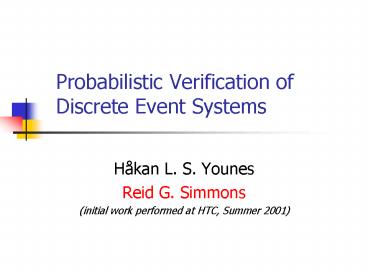Probabilistic Verification of Discrete Event Systems - PowerPoint PPT Presentation
Title:
Probabilistic Verification of Discrete Event Systems
Description:
'The probability is at least 0.7 that the stork satisfies its hunger within 180 seconds' ... 'The Hungry Stork' as a. Discrete Event System. hungry. May 30, ... – PowerPoint PPT presentation
Number of Views:49
Avg rating:3.0/5.0
Title: Probabilistic Verification of Discrete Event Systems
1
Probabilistic Verification of Discrete Event
Systems
- Håkan L. S. Younes
- Reid G. Simmons
- (initial work performed at HTC, Summer 2001)
2
Introduction
- Goal Verify temporal properties of general
discrete event systems - Probabilistic, real-time properties
- Expressed using CSL
- Approach Acceptance sampling
- Guaranteed error bounds
- Any-time properties
3
The Hungry Stork
The probability is at least 0.7 that the stork
satisfies its hunger within 180 seconds
4
The Hungry Stork as aDiscrete Event System
5
The Hungry Stork as aDiscrete Event System
6
The Hungry Stork as aDiscrete Event System
7
The Hungry Stork as aDiscrete Event System
stork sees frog
frog sees stork
stork eats frog
hungry,hunting,seen
not hungry
hungry,hunting
hungry
40 sec
19 sec
2 sec
8
The Hungry Stork as aDiscrete Event System
stork sees frog
frog sees stork
stork eats frog
hungry,hunting,seen
not hungry
hungry,hunting
hungry
40 sec
19 sec
2 sec
For this execution path, at least, the property
holds (total time lt 180 sec)
9
Verifying Probabilistic Properties
- Properties of the form Pr?(X)
- Symbolic Methods
- Exact solutions
- - Works for a restricted class of systems
- Sampling
- Works for all systems that can be simulated
- - Solutions not guaranteed
10
Our Approach Acceptance Sampling
- Use simulation to generate sample execution paths
- Samples based on stochastic discrete event models
- How many samples are enough?
- Probability of false negatives ?
- Probability of false positives ?
11
Performance of Test
1 ?
Probability of acceptingPr? (X) as true
?
?
Actual probability of X holding
12
Ideal Performance
1 ?
Probability of acceptingPr? (X) as true
?
?
Actual probability of X holding
13
Actual Performance
1 ?
Probability of acceptingPr? (X) as true
?
?
Actual probability of X holding
14
SequentialAcceptance Sampling
- Hypothesis Pr?(X)
15
Graphical Representation of Sequential Test
16
Graphical Representation of Sequential Test
- We can find an acceptance line and a rejection
line given ?, ?, ?, and ?
17
Graphical Representation of Sequential Test
18
Graphical Representation of Sequential Test
19
Verifying Properties
- Verify Pr?(?) with error bounds ? and ?
- Generate sample execution paths using simulation
- Verify ? over each sample execution path
- If ? is true, then we have a positive sample
- If ? is false, then we have a negative sample
- Use sequential acceptance sampling to test the
hypothesis Pr?(?)
- How to express probabilistic, real-time temporal
properties as acceptance tests?
20
Continuous Stochastic Logic (CSL)
- State formulas
- Standard logic operators ?, ?1 ? ?2
- Probabilistic operator Pr?(?)
- Path formulas
- Time-bounded Until ?1 Ut ?2
- Pr0.7(true U180 hungry)
- Pr0.9(Pr0.1(queue-full) U60 served)
21
Verification of Conjunction
- Verify ?1 ? ?2 ? ? ?n with error bounds ? and ?
- What error bounds to choose for the ?is?
- Naïve ?i ?/n, ?i ?/n
- Accept if all conjuncts are true
- Reject if some conjunct is false
22
Verification of Conjunction
- Verify ?1 ? ?2 ? ? ?n with error bounds ? and ?
- Verify each ?i with error bounds ? and ?
- Return false as soon as any ?i is verified to be
false - If all ?i are verified to be true, verify each ?i
again with error bounds ? and ?/n - Return true iff all ?i are verified to be true
23
Verification of Conjunction
- Verify ?1 ? ?2 ? ? ?n with error bounds ? and ?
- Verify each ?i with error bounds ? and ?
- Return false as soon as any ?i is verified to be
false - If all ?i are verified to be true, verify each ?i
again with error bounds ? and ?/n - Return true iff all ?i are verified to be true
24
Verification of Path Formulas
- To verify ?1 Ut ?2 with error bounds ? and ?
- Convert to disjunction
- ?1 Ut ?2 holds if ?2 holds in the first state,
or if ?2 holds in the second state and ?1 holds
in all prior states, or
25
More on Verifying Until
- Given ?1 Ut ?2, let n be the index of the first
state more than t time units away from the
current state - Disjunction of n conjunctions c1 through cn, each
of size i - Simplifies if ?1 or ?2, or both, do not contain
any probabilistic statements
26
Verification of Nested Probabilistic Statements
- Suppose ?, in Pr?(?), contains probabilistic
statements
27
Verification of Nested Probabilistic Statements
- Suppose ?, in Pr?(?), contains probabilistic
statements - Pr0.9(Pr0.1(queue-full) U60 served)
- How to specify the error bounds ? and ? when
verifying ??
28
Modified Test
- find an acceptance line and a rejection line
given ?, ?, ?, ?, ?, and ?
29
Modified Test
- find an acceptance line and a rejection line
given ?, ?, ?, ?, ?, and ?
Accept
Continue sampling
Reject
30
Performance
?0.5
?0.7
?0.9
log Epn
p
31
Performance
?0.005
?0.01
log Epn
?0.02
p
32
Performance
??0.001
??0.01
log Epn
??0.1
p
33
Summary
- Algorithm for probabilistic verification of
discrete event systems - Sample execution paths generated using simulation
- Probabilistic properties verified using
sequential acceptance sampling - Properties specified using CSL
34
Future Work
- Apply to hybrid dynamic systems
- Develop heuristics for formula ordering and
parameter selection - Use verification to aid policy generation for
real-time stochastic domains































